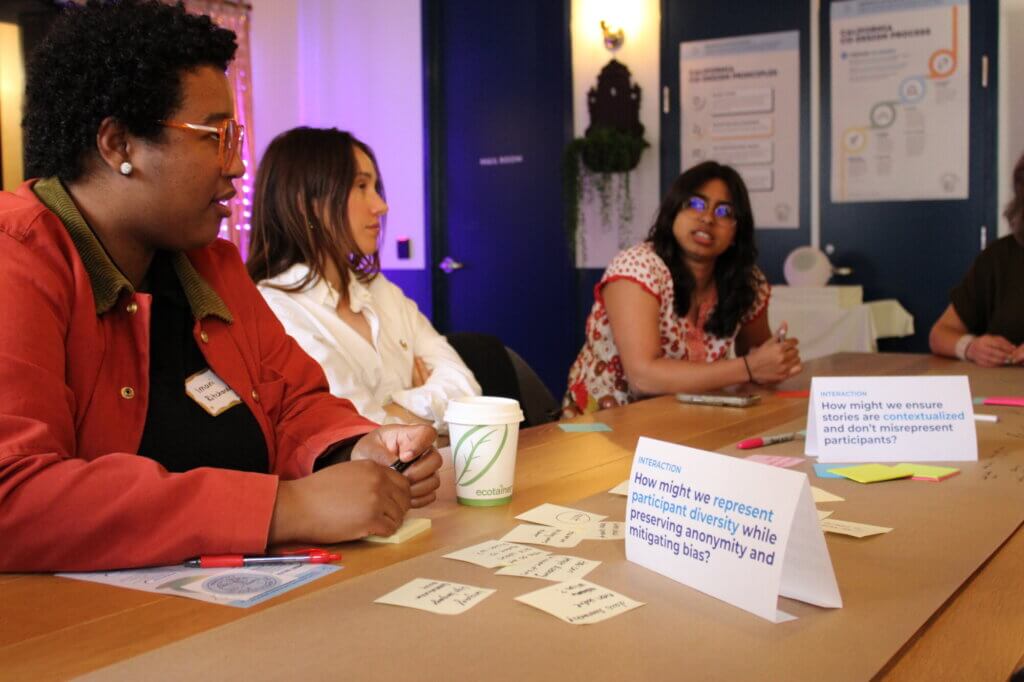Co-Designing Technology for Human-Centered Public Services
What We Learned from Workshopping with Designers at SF Design Week

Participants gather around a table with How Might We questions in our downtown SF office on June 6th for SF Design Week.
Background
In the Spring of 2025, our Ridiculously Hopeful Futures (RHF) project invited community members and public benefits administrators across five California counties to imagine a radically inclusive future. In this future, the State of California has fully embraced listening to community voices through co-design and consults those perspectives to shape public programs and policies.
Community Voices: the real, living expertise of benefits program participants – especially those historically excluded from civic processes.
As part of this speculative exploration, we introduced participants to Benni, a proposed AI assistant designed to relay real community stories directly to decision-makers. Benni doesn’t exist yet, but in a “Ridiculously Hopeful Future,” could act as a kind of ethical, participatory AI: bridging gaps between those using public services and those who design and administer them. You can watch a short video about Benni and the future scenario we tested here. 
By bringing this idea to life with public servants across California, we learned a lot about the ways in which a tool like this could support the work as well as introduce new challenges and concerns.
Workshopping With Designers at SF Design Week (June 2025)
During SF Design Week, we invited designers, engineers, and researchers into our downtown San Francisco office to experience Benni and help us explore questions that surfaced from our workshops. Below are some of the categories we tested:
| Benni – Core Functionality & Design | |
|---|---|
Data Sources
|
Interaction
|
Validation
|
Research Best Practices
|
Our goal was to bring in their expertise in technology and research best practices to explore the next iteration of Benni. Specifically, how we might incorporate the voices of benefits program participants in a way that elevates a range of perspectives and prioritizes consent and privacy.
We’re so grateful to everyone who joined us and made the conversation rich, playful, and rooted in care for different communities.
Convening Designers Across Disciplines
Held at Mindspace SF, our workshop gathered a diverse group of practitioners: UX designers from design agencies, nonprofit technologists, researchers, and software engineers. Unlike our previous public service and government stakeholder workshops, which focused on policy alignment, equity frameworks, and institutional processes, this group zoomed in on productization, interaction design, and continuous validation.
Their approach brought nuanced depth to key challenges we’re working on, especially around data collection and storytelling in the public sphere. Designers pushed us to think not just about what we collect but how those voices live on—who hears them, how they’re stored, and how they can speak up again in various contexts.

Key Insights from Designers
1. Design for Ongoing Validation
Participants emphasized the need for tools that don’t just collect stories once but continue to validate and amplify them. Some ideas included:
- Spotify-style “wraps” showing whose voices are underplayed
- Creative outputs like playlists, postcards, or reels to re-surface unheard narratives
- Apps that prompt and record new stories with consent built-in
2. Center Consent as a Living Process
Consent shouldn’t end with the check of a box. Instead:
- Give participants the option to set expiration dates for their stories
- Build tools that let people track how their voice is used, and opt out or weigh in over time
- Allow for anonymity with options like voice actors or AI voice masks
3. Broaden Participation through Accessibility
From user experience to physical access, the group emphasized designing input methods for a range of experiences:
- Mobile-friendly apps that are intuitive and inclusive
- Integration with existing platforms (e.g., social media, benefits portals)
- Partnerships with nonprofits to support onboarding and training
4. Reframe Public Benefits as Public Goods
There was a strong push to shift how we talk about public programs, not as charity or assistance, but as collective infrastructure. That shift could:
- Encourage more equitable participation
- Support ideas like “jury duty for the digital age,” where people are invited to contribute stories as a civic act
- Justify building storytelling into benefit access as a norm, and not just as a “nice-to-have”
How Designers Expanded the Conversation
Where public sector audiences bring critical insight into feasibility and institutional buy-in, these designers brought attention to emotional resonance, continuity, and systems of feedback. They grounded the conversation in real use cases: How might this show up in someone’s life? How will they know it mattered? Their feedback helped us imagine beyond compliance and accountability, to care, creativity, and connection.

What’s Next—and Why It Matters
We left the workshop energized and challenged. Designers helped us see that collecting stories is just the beginning. True equity comes from designing the full arc of a voice’s journey: from input, to impact, to re-use and consent.
As we continue building our tools and approaches, we’re asking: How do we create systems that honor the humanity of data? How do we let people see—and feel—that their voice made a difference?
We’re so grateful to the Public Benefit Innovation Fund at Digital Harbor Foundation for supporting this work, and to all our collaborators: past, present, and future, for imagining with us. Stay tuned for more stories and insights from the RHF workshops on our Futures page. And sign up for our Futures newsletter here.
